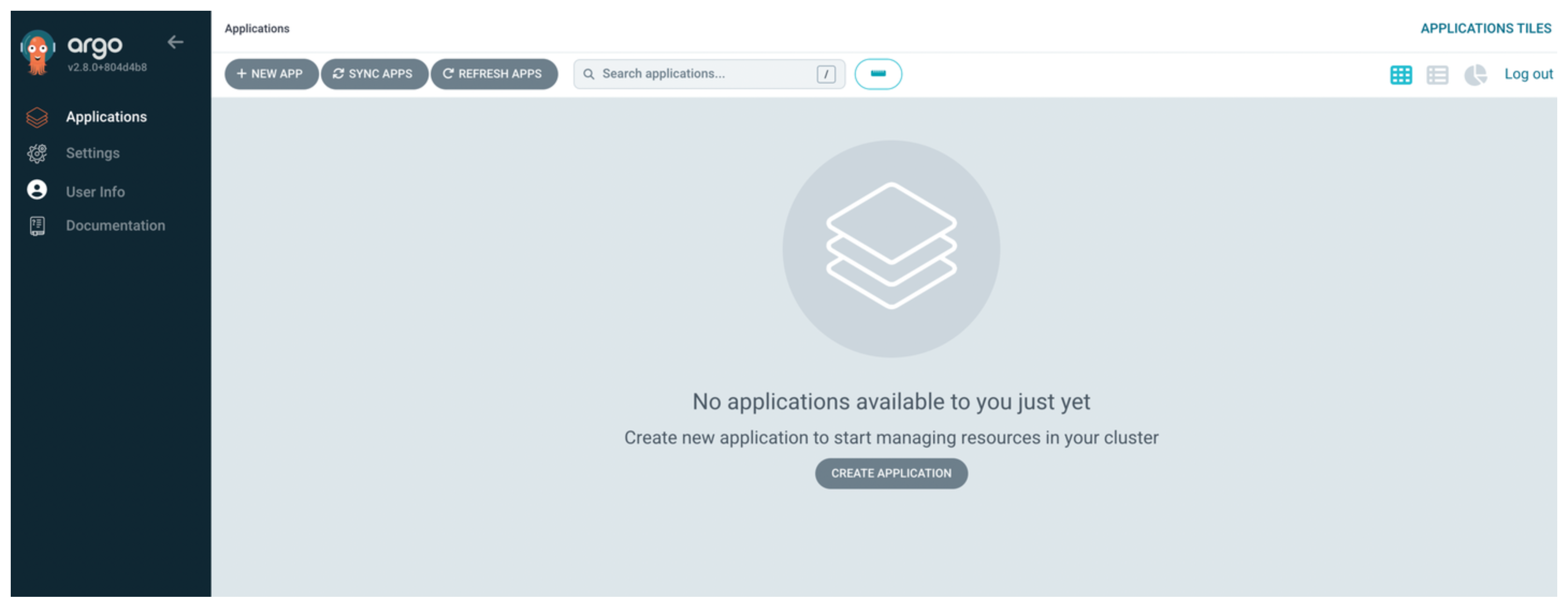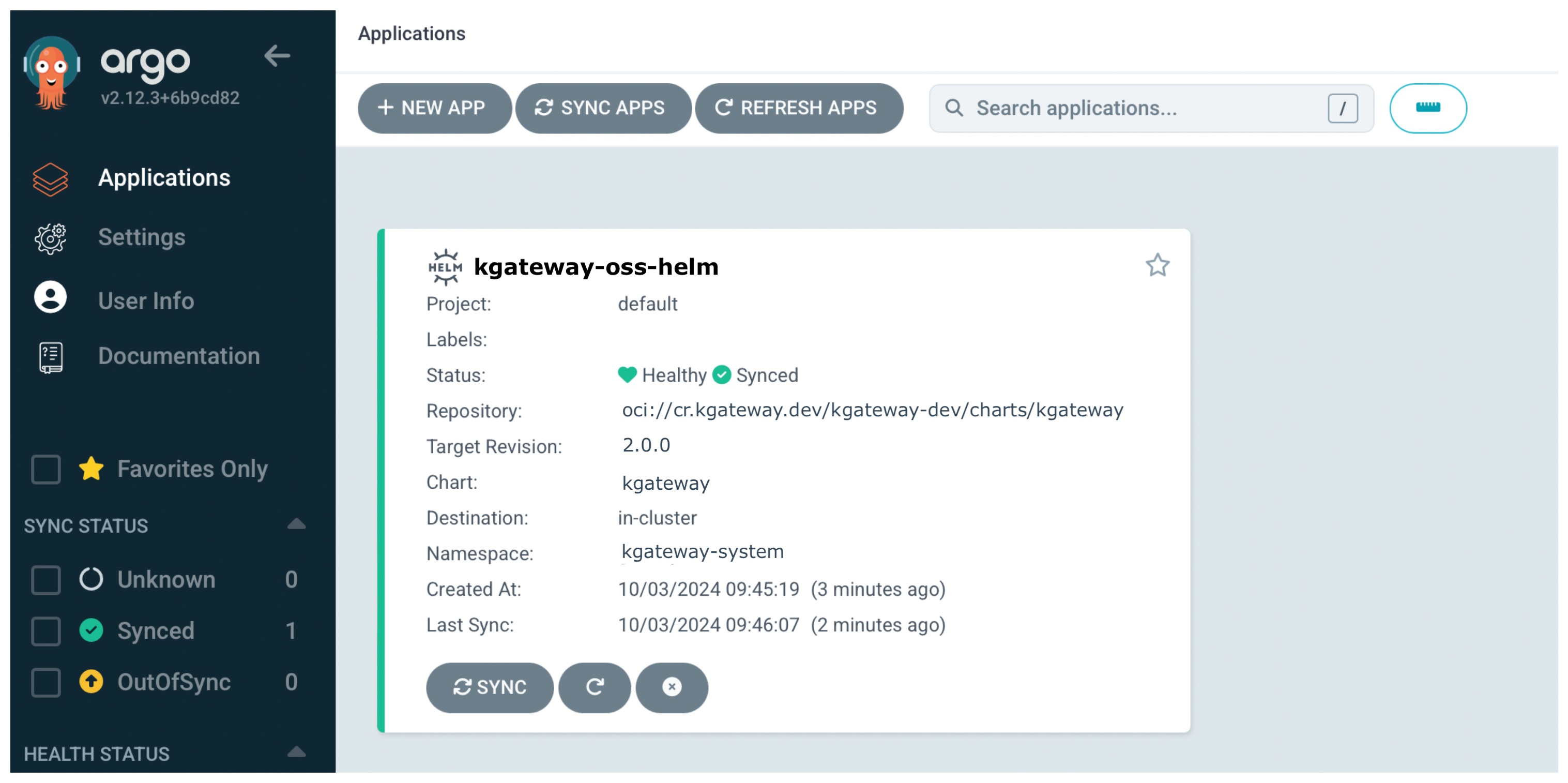ArgoCD
In this installation guide, you install kgateway in a Kubernetes cluster by using Argo CD. Argo CD is a declarative continuous delivery tool that is especially popular for large, production-level installations at scale. This approach incorporates Helm configuration files.
Before you begin
- Create or use an existing Kubernetes cluster.
- Install the following command-line tools.
- Install Argo CD in your cluster.
kubectl create namespace argocd until kubectl apply -n argocd -f https://raw.githubusercontent.com/argoproj/argo-cd/v2.12.3/manifests/install.yaml > /dev/null 2>&1; do sleep 2; done # wait for deployment to complete kubectl -n argocd rollout status deploy/argocd-applicationset-controller kubectl -n argocd rollout status deploy/argocd-dex-server kubectl -n argocd rollout status deploy/argocd-notifications-controller kubectl -n argocd rollout status deploy/argocd-redis kubectl -n argocd rollout status deploy/argocd-repo-server kubectl -n argocd rollout status deploy/argocd-server - Update the default Argo CD password for the admin user to
kgateway.# bcrypt(password)=$2a$10$g3bspLL4iTNQHxJpmPS0A.MtyOiVvdRk1Ds5whv.qSdnKUmqYVyxa # password: kgateway kubectl -n argocd patch secret argocd-secret \ -p '{"stringData": { "admin.password": "$2a$10$g3bspLL4iTNQHxJpmPS0A.MtyOiVvdRk1Ds5whv.qSdnKUmqYVyxa", "admin.passwordMtime": "'$(date +%FT%T%Z)'" }}'
Install
Install kgateway by using Argo CD.
-
Install the custom resources of the Kubernetes Gateway API version 1.4.0.
kubectl apply -f https://github.com/kubernetes-sigs/gateway-api/releases/download/v1.4.0/standard-install.yamlExample output:
customresourcedefinition.apiextensions.k8s.io/gatewayclasses.gateway.networking.k8s.io created customresourcedefinition.apiextensions.k8s.io/gateways.gateway.networking.k8s.io created customresourcedefinition.apiextensions.k8s.io/httproutes.gateway.networking.k8s.io created customresourcedefinition.apiextensions.k8s.io/referencegrants.gateway.networking.k8s.io created customresourcedefinition.apiextensions.k8s.io/grpcroutes.gateway.networking.k8s.io createdℹ️If you need to use an experimental feature such as TCPRoutes, install the Gateway API experimental CRDs and enable the experimental feature gate setting (KGW_ENABLE_GATEWAY_API_EXPERIMENTAL_FEATURES) in your kgateway installation. For more information, see Experimental features in Gateway API. -
Port-forward the Argo CD server on port 9999.
kubectl port-forward svc/argocd-server -n argocd 9999:443 -
Open the Argo CD UI.
-
Log in with the
adminusername andkgatewaypassword.

-
Create an Argo CD application to deploy the kgateway CRD Helm chart.
kubectl apply -f- <<EOF apiVersion: argoproj.io/v1alpha1 kind: Application metadata: name: kgateway-crds-helm namespace: argocd spec: destination: namespace: kgateway-system server: https://kubernetes.default.svc project: default source: chart: kgateway-crds helm: skipCrds: false repoURL: cr.kgateway.dev/kgateway-dev/charts targetRevision: v2.2.0-main syncPolicy: automated: # Prune resources during auto-syncing (default is false) prune: true # Sync the app in part when resources are changed only in the target Kubernetes cluster # but not in the git source (default is false). selfHeal: true syncOptions: - CreateNamespace=true EOF -
Create an Argo CD application to install the kgateway Helm chart.
⚠️When using the development build 2.2.0-main , add thecontroller.image.pullPolicy=Alwaysparameter to ensure you get the latest image. You might also want to enable the experimental feature gate,--set controller.extraEnv.KGW_ENABLE_GATEWAY_API_EXPERIMENTAL_FEATURES=true.kubectl apply -f- <<EOF apiVersion: argoproj.io/v1alpha1 kind: Application metadata: name: kgateway-helm namespace: argocd spec: destination: namespace: kgateway-system server: https://kubernetes.default.svc project: default source: chart: kgateway helm: skipCrds: false parameters: - name: controller.image.pullPolicy value: "Always" - name: controller.extraEnv.KGW_ENABLE_GATEWAY_API_EXPERIMENTAL_FEATURES value: "true" repoURL: cr.kgateway.dev/kgateway-dev/charts targetRevision: v2.2.0-main syncPolicy: automated: # Prune resources during auto-syncing (default is false) prune: true # Sync the app in part when resources are changed only in the target Kubernetes cluster # but not in the git source (default is false). selfHeal: true syncOptions: - CreateNamespace=true EOF -
Verify that the control plane is up and running.
kubectl get pods -n kgateway-systemExample output:
NAME READY STATUS RESTARTS AGE gateway-certgen-wfz9z 0/1 Completed 0 35s kgateway-78f4cc8fc6-6hmsq 1/1 Running 0 21s kgateway-resource-migration-sx5z4 0/1 Completed 0 48s kgateway-resource-rollout-28gj6 0/1 Completed 0 21s kgateway-resource-rollout-check-tjdp7 0/1 Completed 0 2s kgateway-resource-rollout-cleanup-nj4t8 0/1 Completed 0 39s -
Verify that the
kgatewayGatewayClass is created. You can optionally take a look at how the gateway class is configured by adding the-o yamloption to your command.kubectl get gatewayclass kgateway -
Open the Argo CD UI and verify that you see the Argo CD application with a
HealthyandSyncedstatus.

Next steps
Now that you have kgateway set up and running, check out the following guides to expand your API gateway capabilities.
- Learn more about kgateway, its features and benefits.
- Deploy an API gateway and sample app to test out routing to an app.
- Add routing capabilities to your httpbin route by using the Traffic management guides.
- Explore ways to make your routes more resilient by using the Resiliency guides.
- Secure your routes with external authentication and rate limiting policies by using the Security guides.
Cleanup
You can remove the resources that you created in this guide.Follow the Uninstall with Argo CD guide.